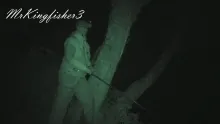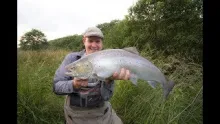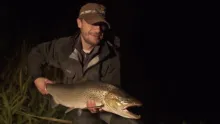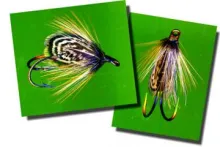This one of the really genuine Danish flies for sea trout in the streams. The Moor Fly (Hedefluen in Danish) in some fishers eyes work magic and can at times be the most dominating fly on certain Danish sea trout streams.

This one of the really genuine Danish flies for sea trout in the streams. The Moor Fly (Hedefluen in Danish) in some fishers eyes work magic and can at times be the most dominating fly on certain Danish sea trout streams.
It was probably originated on the banks of the stream Skjern Aa, but who tied the first 'Heiflow' - as it was called in the local dialect - that is not known.
It has some resemblance with the red tag, but has been modified through decades. Locally it varies a lot: white wings, hair wings, no body hackle, composite wing with marabou. But its main features: big red tail, silver tag, peacock body and a fairly heavy soft hackle is almost found in all of them.
Some will say that it's a spring pattern, but locally it's used all season.
Hook: Size 2 double heavy wire down eye
Thread: Black and red
Tail: Red hackle fibers
Tag: Narrow flat silver tinsel
Body hackle: Chestnut brown cocks' hackle
Rib: Oval silver tinsel
Body: Peacock herl
Wing: Two furnace cocks hackles
Hackle: Soft brown hen hackle
Head: Red
- Cover the hook shank with a smooth layer of black thread. Let the thread hang down to reach the hook point
- Tie in tail fibers. They should reach slightly beyond the hook bend
- Cut surplus
- Tie in a strip of silver tinsel for the tag
- Make a few turns of tinsel backwards and then forwards again
- Tie down and cut surplus
- Tie in the body hackle tip first, shiny side out
- Tie in the oval silver tinsel
- Tie in 6-10 strands of peacock herl
- Make a herl rope with the herl and wind it forwards in close turns to form a thick, cylindrical body.
- Tie down and cut surplus
- Follow with the hackle, tie down and cut
- Wind the ribbing in the opposite direction
- Tie down and cut surplus
- Select two furnace cocks hackles and strip the webby part plus a little to get a suitable length. The wing should reach the same point as the tail
- Mount the wings dull side to dull side on top of the hook
- Tie in a brown hackle, tip first, shiny side out, and hackle stem upwards
- Wind the hackle clockwise in wet fly style, folding it over and stroking barbs to the rear of the hook. The hackle should be heavy
- Tie down and cut surplus
- Whip finish the black thread and start the red
- Form a nice, small head
- Whip finish and varnish
- Log in to post comments







